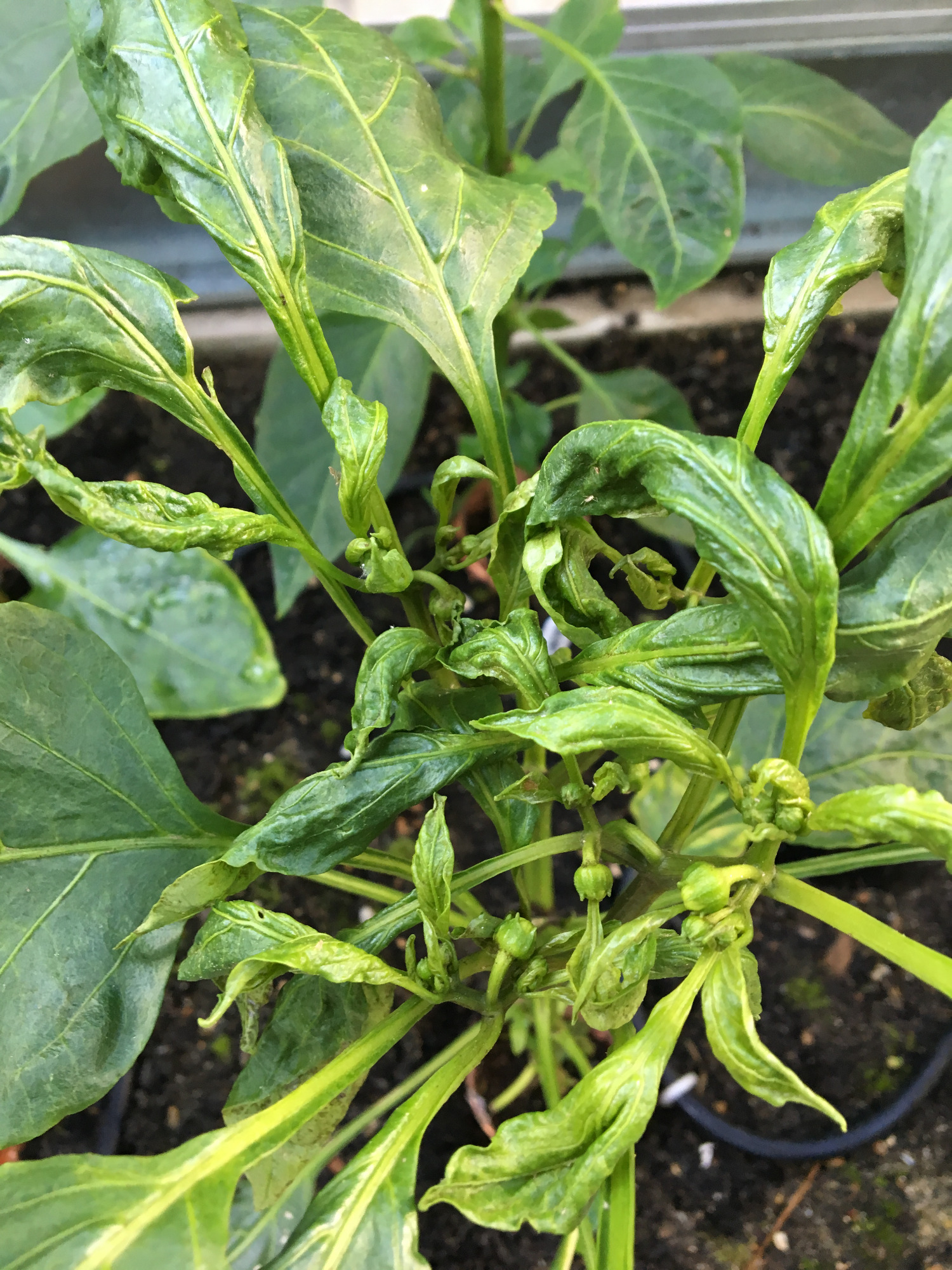I do not have a picture of my peppers to post but I did find this on Google which represents what my peppers look like. Here are the details that I can share. I am hoping someone can give me advise moving forward to avoid this.
My raised beds are now two years old. Soil added was originally 1/3 sphagnum peat, 1/3 vegetative compost and 1/3 perlite. I have amended it with stuff like black cow, mushroom compost, homemade compost, blood meal, bone meal, green sand and rock phosphate since. The first year a few pepper plants would exhibit what you see below. This was in a single bed with about a dozen sweet banana peppers. After the first month of all the peppers looking great about 4 of them started to look like this. The leaves formed when it was healthy continued to look fine where new growth looked like this. I let things be for the rest of the grow with the peppers unaffected grew three times the size while the others remained stunted to nearly the same size. New leaves never got larger then an inch or so. Affected and unaffected were all within feet of each other.
Since then all peppers plants I grow in my beds end up with this. So I did a few experiments.
I grew two peppers hydroponically outdoors in the same general area and 4 indoors. All of them grew exceptionally well and produced lots of fruit. I then grew peppers in solo cups until they were about 6 inches tall, outdoors. The only thing I noticed with them were whiteflies under the leaves. I had to spray neem oil every few days to keep them away but they always came back. When I transplanted them they would end up looking like the picture below within a week or two.
Some more facts to add:
I had a few soil tests done by IFAS to assure that it was not a nutrient problem. The tests came back positive for all nutrients with the only thing of concern was the PH which is about 7.6. I know 6.5 is more ideal but I don't think this is where the problem is. If you disagree please let me know. I can try to add sulfur to see if that changes anything. I don't believe this is high enough to cause a calcium lockout.
The soil drains well and doesn't stay wet or too moist so I don't believe water is an issue.
I see in this picture that there might be some mites on this plant. I do not detect insects other then some aphids or whiteflies that I take care of right away. They may come back a bit later but never in large quantities as I keep on top of killing them when present. Could they be transmitting a disease to cause this?
I am dumbfounded to be honest.

My raised beds are now two years old. Soil added was originally 1/3 sphagnum peat, 1/3 vegetative compost and 1/3 perlite. I have amended it with stuff like black cow, mushroom compost, homemade compost, blood meal, bone meal, green sand and rock phosphate since. The first year a few pepper plants would exhibit what you see below. This was in a single bed with about a dozen sweet banana peppers. After the first month of all the peppers looking great about 4 of them started to look like this. The leaves formed when it was healthy continued to look fine where new growth looked like this. I let things be for the rest of the grow with the peppers unaffected grew three times the size while the others remained stunted to nearly the same size. New leaves never got larger then an inch or so. Affected and unaffected were all within feet of each other.
Since then all peppers plants I grow in my beds end up with this. So I did a few experiments.
I grew two peppers hydroponically outdoors in the same general area and 4 indoors. All of them grew exceptionally well and produced lots of fruit. I then grew peppers in solo cups until they were about 6 inches tall, outdoors. The only thing I noticed with them were whiteflies under the leaves. I had to spray neem oil every few days to keep them away but they always came back. When I transplanted them they would end up looking like the picture below within a week or two.
Some more facts to add:
I had a few soil tests done by IFAS to assure that it was not a nutrient problem. The tests came back positive for all nutrients with the only thing of concern was the PH which is about 7.6. I know 6.5 is more ideal but I don't think this is where the problem is. If you disagree please let me know. I can try to add sulfur to see if that changes anything. I don't believe this is high enough to cause a calcium lockout.
The soil drains well and doesn't stay wet or too moist so I don't believe water is an issue.
I see in this picture that there might be some mites on this plant. I do not detect insects other then some aphids or whiteflies that I take care of right away. They may come back a bit later but never in large quantities as I keep on top of killing them when present. Could they be transmitting a disease to cause this?
I am dumbfounded to be honest.

